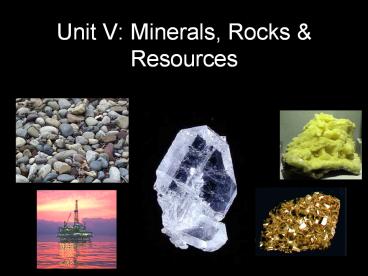Unit V: Minerals, Rocks - PowerPoint PPT Presentation
Title:
Unit V: Minerals, Rocks
Description:
Unit V: Minerals, Rocks & Resources Organic (Bioclastic): **sedimentary rocks Metamorphic Rocks: *** There is NO MELTING of the existing rock! – PowerPoint PPT presentation
Number of Views:211
Avg rating:3.0/5.0
Title: Unit V: Minerals, Rocks
1
Unit V Minerals, Rocks Resources
2
What is a mineral?
- Mineral
3
Meaning that minerals
4
5
Physical Properties of Minerals
- Color
Quartz
6
- Luster how a mineral reflects light (shine)
Metallic vs. Nonmetallic
Dull, earthy, Waxy, glassy
Looks like Metal
7
- Streak
8
- Hardness
- the hardness is based on a number between 1 and
10with 1 being the softest (talc) and 10 being
the hardest (diamond)
9
10
- Cleavage or Fracture
- Cleavage
11
- Fracture
12
- Density
Very heavy for its size high density
13
- Chemical Properties
Acid Fizz
Salty Taste
Rotten Egg Smell
14
What are minerals made out of?
- Elements
Halite (NaCl)
Sulfur (Element)
15
Why do minerals made from the same elements
exhibit different properties?
Carbon Atoms (Diamond)
Carbon Atoms (Graphite)
16
- Silicate Minerals
(4) Oxygen
Silicon in center
90 of all minerals most common
17
(No Transcript)
18
What is a Rock?
19
- Igneous Rocks
- molten rock can either be magmabelow the
surface, or lavaabove the surface
20
Two Igneous Rock Forming Environments
- Extrusive (external)
21
- Intrusive (internal)
22
How are igneous rocks classified?
- Texture
23
- Slow Cooling
Large Crystals
24
- Fast Cooling
Small Crystals
25
- Color
- Felsic
26
- Mafic
27
(No Transcript)
28
- Sedimentary Rocks
Pieces of rocks
Chemical Reaction
29
Three Types of Sedimentary Rocks
- Clastic
30
- Finecant see (clay)
- Mediumcan see (sand)
- Coarsecan see (pebbles)
Conglomerate
Shale
Sandstone
31
(No Transcript)
32
- Chemical (crystalline)
Rock Salt (evaporation)
Rock Gypsum (chemical)
33
(No Transcript)
34
- Organic (Bioclastic)
35
(No Transcript)
36
- sedimentary rocks
37
- Metamorphic Rocks
38
- There is NO MELTING of the existing rock!
What happens if a rock melts?
Igneous
39
Two types of metamorphism
- Contact Metamorphism
40
(No Transcript)
41
- Regional Metamorphism
42
Two Classifications of Meta Rocks
- Foliated
43
(No Transcript)
44
- Non-foliated-
45
(No Transcript)
46
Inferences we can make by looking at rocks
Marine Fossils
Sedimentary / Ocean
Igneous / cooled fast
Glassy
47
Where do you find the three types of rocks?
- Sedimentary
48
- Igneous
Granite
Basalt
49
- Metamorphic
50
- Intrusive igneous and metamorphic rocks are
exposed due to millions of years of weathering
(breaking down) erosion (washing away)
51
Rock Cycle
model that shows how rocks change
52
Natural Resources
- Natural Resources
53
Two Types of Resources
- Renewable
54
- Non-renewable
55
- Alternative Energy Sources































